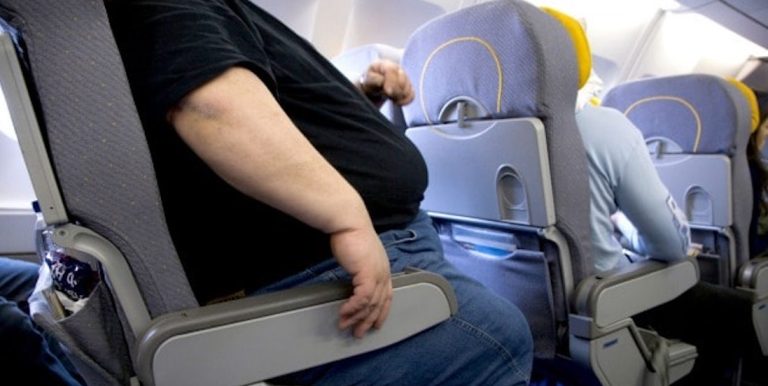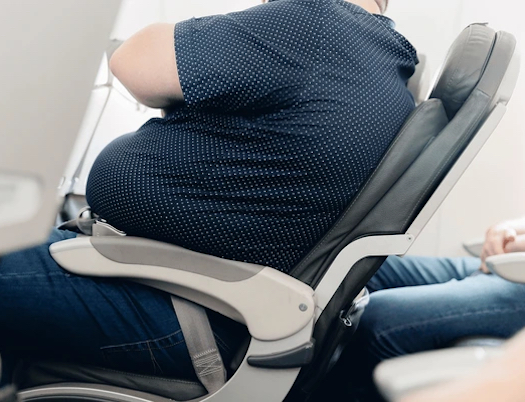
Industries face mounting pressure over extra charges for larger accommodations amid equality concerns

New York, N.Y. – The recent reversal of a City Council in the U.K.’s controversial “fat tax” on larger burial plots reflects a broader pattern of size discrimination across multiple industries, from airlines charging for extra seats to theaters limiting accessibility options.
As disability rights advocates challenge these practices, businesses face increasing pressure to balance operational costs with anti-discrimination principles.
The cemetery controversy in England’s city of Wolverhampton, which charged families an additional £406 ($515) for burial plots wider than 30 inches (76 cm), mirrors debates playing out across sectors where physical size creates additional costs. Unlike the cemetery’s quick policy reversal, many industries continue wrestling with how to fairly address size-related accommodations without facing discrimination lawsuits.
Airlines Navigate Complex Size Policies
The airline industry presents perhaps the most visible example of size-based pricing, with policies varying dramatically between carriers. Canadian courts have ruled that purchasing a ticket buys transportation to a destination rather than merely a designated space, forcing airlines to accommodate passengers with excess weight by offering a second seat at no additional charge as a human rights issue.

Southwest Airlines has maintained a Customer of Size policy for more than 30 years, allowing overweight or obese customers to get an extra seat free of charge.
However, this generous approach stands in stark contrast to most U.S. carriers, which require passengers to purchase additional seats if they cannot fit comfortably in standard seating.
Dr. Rebecca Chen, a civil rights attorney specializing in disability law, explains the legal complexities: “The challenge lies in determining whether size-related charges constitute legitimate business practices or discriminatory policies, particularly when medical conditions contribute to size differences.”
In Canada, the “one person, one fare” policy passed by the Canadian Transportation Agency in 2008 recognizes obesity as a disability, requiring passengers to be “functionally disabled by obesity” to qualify for free extra seats, though this only applies to domestic flights.
Theater Industry Balances Access And Revenue
While airlines face scrutiny over passenger size policies, theaters encounter different accessibility challenges. Under the Americans with Disabilities Act, theaters must provide accessible seating for wheelchair users and individuals with mobility impairments at the same ticket prices as standard seats.
However, premium seating categories create complications. Many theaters now charge extra for luxury recliners, wider seats, and premium locations, potentially creating economic barriers for individuals requiring more spacious accommodations. Michael Rodriguez, executive director of the Theater Accessibility Alliance, notes that while ADA compliance ensures basic access, it doesn’t address affordability issues.
“A person using a wheelchair might have access to designated spaces, but those spaces might only be available in premium-priced sections,” Rodriguez explained. “This creates indirect discrimination through economic barriers.”
Healthcare Equipment Reveals Manufacturing Disparities
The medical equipment industry faces unique challenges in size-based pricing, particularly for wheelchair manufacturers and mobility device producers. Standard wheelchairs accommodate users up to 250 pounds (113 kg), while bariatric wheelchairs for users exceeding 300 pounds (136 kg) can cost three to five times more.
Sarah Williams, a disability rights advocate who uses a bariatric wheelchair, describes the financial burden: “I didn’t choose to need a heavier-duty wheelchair, but I’m penalized financially for requiring specialized equipment. Insurance often covers basic models but leaves patients paying thousands out-of-pocket for appropriate sizing.”
Dr. James Patterson, a rehabilitation engineer, argues that manufacturing costs justify price differences. “Bariatric equipment requires stronger materials, different design specifications, and smaller production runs, which naturally increases costs,” Patterson said. “However, we must consider whether these market-driven prices create healthcare equity issues.”
Clothing Industry Confronts Plus-Size Pricing
The fashion industry has long faced criticism for plus-size pricing, with many retailers charging 10-20% more for extended sizes. Companies argue that larger garments require more fabric and specialized patterns, while critics contend this represents size discrimination.
Target Corporation made headlines in 2015 by eliminating plus-size price premiums, while other major retailers maintain differential pricing. Fashion advocate Lisa Thompson argues that clothing represents a basic necessity, making size-based pricing particularly problematic.
“When essential items cost more based on body size, it creates economic discrimination that disproportionately affects people with medical conditions, genetic factors, or socioeconomic challenges that influence weight,” Thompson said.
Legal Framework Evolves Slowly
The legal landscape surrounding size discrimination remains complex and inconsistent across jurisdictions. While the U.K.’s Equality Act 2010 provided grounds for challenging Wolverhampton’s cemetery fees, U.S. law offers fewer protections for size-based discrimination outside specific disability contexts.
Professor David Martinez of Harvard Law School studies discrimination law and notes growing legal recognition of size-related civil rights. “We’re seeing courts increasingly willing to examine whether size-based policies have discriminatory effects, even when not explicitly intended to discriminate,” Martinez said.
Some states have introduced body size discrimination legislation, while others rely on existing disability rights frameworks. The patchwork of protections creates uncertainty for both businesses and consumers navigating size-related policies.
Economic Arguments Meet Equality Concerns
Industries defending size-based pricing consistently cite legitimate cost differences for larger accommodations. Airlines point to fuel costs and space limitations, while equipment manufacturers emphasize material and engineering expenses. However, disability advocates argue that treating size as purely an individual responsibility ignores medical, genetic, and socioeconomic factors.
Dr. Amanda Foster, an economist specializing in discrimination studies, suggests alternative approaches: “Rather than individual surcharges, industries could distribute costs across all consumers or seek public subsidies for accessibility accommodations, similar to disability access requirements.”
Industry Responses Vary Widely
While Wolverhampton quickly reversed its cemetery policy under pressure, other industries show mixed responses to size discrimination criticisms. Southwest Airlines maintains its inclusive policy despite some customer complaints, while most U.S. carriers continue charging for additional seats.
The restaurant industry faces growing scrutiny over booth and chair sizing, with some establishments investing in universal design furniture that accommodates various body sizes without premium charges. Retail stores increasingly offer size-inclusive clothing lines at standard prices, though premium pricing persists in many segments.
Future Outlook For Size Equality
As body positivity movements gain momentum and medical understanding of weight-related conditions improves, pressure on industries to reconsider size-based policies will likely intensify. The Wolverhampton cemetery case demonstrates how quickly public opinion can force policy changes when discrimination concerns align with human dignity principles.
Civil rights organizations are developing coordinated strategies to challenge size discrimination across industries, while businesses seek guidance on balancing operational needs with equality obligations. The outcome of these tensions will shape how society addresses physical diversity in commercial and public spaces.
As one disability advocate noted following Wolverhampton’s policy reversal, “Dignity shouldn’t be priced by the pound, whether in death or in life. The question now is whether other industries will learn from this example or wait for their own public relations crisis.”
Summary
Multiple industries face scrutiny over size-based pricing policies following Wolverhampton’s cemetery “fat tax” reversal. Airlines, theaters, and manufacturers grapple with balancing operational costs against anti-discrimination concerns. While Canadian courts mandate free airline seats for obese passengers and Southwest Airlines offers inclusive policies, most U.S. carriers charge extra fees. The debate highlights tensions between legitimate business costs and civil rights protections, with legal frameworks varying significantly across jurisdictions and industries adapting at different rates.